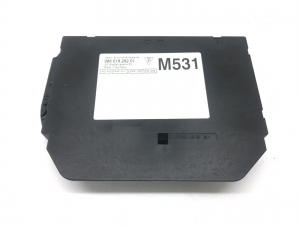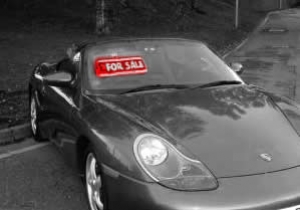Displaying items by tag: boxster

Your Boxster or Cayman is in the best of hands at JMG Porsche, where even with servicing we go beyond the factory schedule.
The factory schedule for many models called for a service every two years, which was fine when the car was new and to make the car last beyond the factory warranty without issue. However we strongly recommend that all models are serviced annually, alternating between a minor and a major service each year. Click here and read our article for more information.
Servicing and repair advice for the the Boxster and Cayman models.
Service interval - We strongly advise that all Porsche cars are serviced every year, with a major service every two years.
The service schedule can be confusing with some service items needing to be performed every X amount of years, with other items being specified every Y amount of miles.
At JMG Porsche we have built a database for each model car, where every two years of age for your car, has listed the major service it requires in that year, which combined with every year in between major services the car having an annual service.
This means that for your model of Porsche, we can provide you with a plain price list for servicing, no matter what year your car was made, which makes it easy to see what service items are due and what the total cost will be.
To get a copy of the current service guide and price list for your Porsche, just email us to have your copy emailed to you in PDF format.
Eventually we plan on making it possible to register to the website and be able to download the latest version of this price list - Watch this space!
Engine failures - Not nearly as common as horror stories on the internet would have you believe, but there are still worthwhile ways of avoiding unexpected large engine rebuild costs. One of which is proper servicing by a real Porsche specialist, which may not need cost as much as you think. There are also some ways to avoid unexpected bills by following some of our other advice bellow.
Brake fluid - Did you realise this should be changed every two years? Not doing this can cause problems with expensive parts within your car, such as the ABS pump or any part of the brake hydraulics due to water contamination as the brake fluid actually sucks moisture out of the air (hydroscopic), so even if the car is not used, the brake fluid must be changed every two years!
Water Pump - Often thought of as a part which fails with age, mileage and quite suddenly, leaving you stranded, our expert technicians are used to inspecting these during services, and so may spot tell tale signs of failure long before they become an issue, so saving you from the indignity of being broken down at the side of the road.
IMS Bearing - The famous intermediate shaft bearing (IMS Bearing) is an important bearing within the engine. These can fail on pre 2005 models of Boxster and cause catestrophic damage to the engine, sometimes costing thousands to repair. However there is a better design of bearing available, which our engine specialists at JMG Porsche have developed some cost effective ways to install and remove the risk of this kind of engine failure. Typically, the most cost effective time to replace this bearing with the better design is at the same time as a clutch replacement. However if you do not need a clutch now, or own a tiptronic Boxster, then we can perform this job at any time.
RMS - Rear main seal - Something else you might see horror stories on the internet about, these used to be a real problem and Porsche re designed the part several times to arrive at the current design which is the only one we at JMG Porsche use. Like an IMS Bearing replacement, this is best performed during a clutch change, however on tiptronic models or on cars not needing a clutch, they can be changed at any time.
Transmission services - Not clearly noted by Porsche for when the transmission should be serviced and this vital expensive part of your car should not be overlooked. Just like your engine, the transmission is filled with oil/transmission fluid, which over time degrades. Not only this, but not many realise that many Porsche transmissions also contain a filter, which becomes clogged over time and can starve your transmission of lubrication, causing expensive repairs. We recommend all Porsche transmissions are serviced every 4 years or 40,000 miles, whichever comes soonest.
Air Oil Separator - If your Porsche is producing some smoke, especially when it starts up in the morning, it could be that the air oil separator has failed rather than your whole engine being damaged. This simple device is designed to allow your engine to pass polution regulations and should not cost the earth to replace, at least much less expensive than rebuilding an engine!
Drive Belt - Many of you may have had cars where a drive belt, timing belt or cam belt needs to be changed at a regular interval. Your Porsche model has a belt which should be changed every 4 years. Failure to do so can cause instant overheating, loss of power steering and damage to the engine very suddenly. We recommend you have this changed at least every 4 years.
Heavy clutch? - A heavy feeling clutch which is stiff to use is not normal on a Porsche and often a sign that the clutch has almost worn out. Ignoring this can cause further damage, such as to the dual mass flywheel and clutch fork.
Alarm system - At JMG Porsche we are experts of all Porsche security systems and have reverse engineered all the various control units. This not only means we can program new alarm control units and keys to your car, just as the main dealer can, but in some cases we can repair your old alarm control unit and keys, or in some cases recover your old keys to be used on the new alarm control unit, which is a service unique to JMG.
Alarm system causes - In most cases the cause of alarm control unit failure is water damage, we can perform modifications to your Porsche model to help mitigate the chances of this happening to your Porsche.
The importance of routine annual servicing.
Everyone knows that a car needs to be serviced to keep it reliable and to avoid expensive repairs.
However there are two occasions where Porsche owners may believe that their car does not need servicing every year.
“But the service book says to service the car every two years.”
Many more modern Porsche models specify two yearly servicing in the service book for the car, which is fine for the first four years of the car's life, as the factory are focussed on the car lasting beyond the duration of the factory warranty. Beyond this, you are on your own.. However we will explain later in this article why this can be a big mistake.
“But I only cover a few miles per year.”
Because often servicing is specified in the service book as yearly or every other year, but also at a set mileage, many people believe that if they have only covered 200 miles in a year, that the car does not need a service.
However, chemistry within your engine will turn your oil from a protecting fluid, into a toxic chemical soup which can literally eat your engine components alive.
Engine oil over two years old is where chemistry becomes your enemy!
Once you start your engine with fresh engine oil a process begins where the oil will be contaminated with hydrocarbons from the combustion process, even if the engine was only started once, when the engine oil has been mixed with these chemical compounds for a year, the oil will have broken down and the chemicals will have become more toxic to your engine.
The engine oil will have begun life as a relatively neutral compound, neither overly acidic or caustic. However hydrocarbons from combustion, entering the oil past your piston rings will have begun to change all of that, some of these compounds only need moisture to become even more toxic.
You may not realise but when your engine is stopped and cooled, any moisture from humidity in the air will collect and condense within the engine and drain back into the oil, more humid air will enter the engine and this also will condense. This moisture will kick start other chemical reactions within the engine oil and especially reacting with the combustion by products within the no longer fresh engine oil.
When the engine is next started, fresh chemical reactions begin, additives within the oil can be destroyed and the chemical make up of the oil within the engine changes further.
This vicious circle is worse with infrequently used cars, as regular use will cause the moisture to evaporate away and have less time to damage the molecules and composition of the engine oil.
This problem is also made worse the longer the engine oil is within the engine, one year is fine, but two years can mean that the engine oil has become very toxic for your engine.
Another problem with the changing chemical composition of the engine oil is that these processes can produce sludge, varnishes and other unwelcome byproducts within your engine.
The proof.
A good example of this are the late Porsche 996 and early 997 engines which share the same engine oil controlled hydraulic solenoids, in the 996 models with yearly servicing these rarely fail, however in the 997 models with two yearly servicing they fail on a reasonably regular basis, likewise with the cam followers. Repairing these consequences of the two yearly services, even when that is what the service book calls for, can costs thousands of pounds to repair!
Beyond the engine oil, many other items are lubricated during a service, and these lubricants are designed to be re-applied every year at most, which means without regular lubrication the components will fail. A good example are the gear selector cables on Boxster and 911 models, on the pre 2005 models (with yearly servicing) they rarely fail, however on the post 2005 models (with two yearly servicing) we now find we need to replace them relatively frequently.
Another example would be that every 996 or 997 which has suffered bore scoring issues that we have seen, has been one specified with two yearly servicing!
A conspiracy by the manufacturers?
Some would say this is a conspiracy by the manufacturers to make more money on selling parts and repairs out of warranty.
However we believe they are just trying to make the car's seem more attractive to new car buyers due to low servicing costs.
Whatever the reason, the person who suffers is usually the person who owns the car when it is over 5 years old, by which time the damage of infrequent servicing are already done and getting worse every time the pattern continues.
There are many other consequences of not having your Porsche serviced every year.
Another good example might be suspension bushes, if replaced as soon as they become aged or worn, the cost of repairs is just the bushes and labour. However if they are left until they have symptoms obvious to the driver the damage will also be to the tyres, which we all know on a Porsche are not cheap!
The solution to this is to always try to buy a car which has been serviced every year, even if the model is specified by the factory to be serviced every two years, and never buy a car which has had the servicing deferred because it had not covered many miles between services.
Beyond this, even if the car has skipped services in the past, whatever model it is, have it serviced every year and follow the advice of your Porsche specialist of any additional items which need replacement, such as drive belts, water-pumps, coolant, brake fluid, brakes etc.. Not following this advice could cost you thousands of pounds if neglected.
A service is a service wherever it is performed, right?
A last note, it is important who you choose to service your Porsche. Any garage can change the oil in your Porsche, but a true specialist will check much more during the process and know what to look for.
Checking the old engine oil for consistency, smell and inspecting it under a powerful light will warn of many other potential issues with the car, such as early signs of bearing failure, fuel pressure, fuel injector condition and much more, all much cheaper to repair before their issues become more chronic and expensive.
Expert eyes will be looking for common problems with each model and year that an average garage will miss, which will cost you much more money later, if not spotted now.
“What else to do?”
Other than all this, enjoy your Porsche, we have found conclusively over the years that the cars which are not used on a regular basis and not driven hard, will suffer more acute problems than those driven hard on a regular basis.. Think of your Porsche as a race horse, it needs to stretch it's legs on a regular basis, otherwise it will stop being a race horse and turn into a stiff old nag!
The Porsche security system in the Porsche Boxster 986 models (up to 2004) and the 996 models upto 2005 can be problematic. When faulty they can cause all kinds of strange behaviour, including winding windows up and down, the car not locking or unlocking with the remote or in some cases with the key even, as well as the car failing to start or any combination of these problems.
To help the Porsche community get to the bottom of problems they may be experiencing, we have written this 996/986 Security system 101 article.
Q: Do all Boxster 986 and 996 models have a factory fitted alarm and immobiliser?
A: All 986 and 996 models do have an immobilser, nearly all of them have a combined alarm and immobiliser (I am yet to see one of the rare ones which has the immobiliser only)
For the purposes of this security system primer, we will assume that all the 986 and 996 models are the versions with the combined alarm and immobiliser.
Over the last 20 years since we first started repairing the Boxster and 996 models, we have had to replace hundreds of key remotes and alarm control units, the details of the inner workings of both are an undocumented mystery with Porsche releasing very few details for obvious reasons.
Without having the proper Porsche PST2 (Porsche system tester two) official diagnostic computer, or one of the later PIWIS or PIWIS2 computers, normally only available at Porsche main dealers, or super-duber independents like JMG Porsche, a new alarm control unit or key remote can not be programmed to work with your car.
Even with one of these super amazing factory tools, you also need special numbers, unique to each car, to program the new control units, previously only available from the Porsche main dealer network.
By the time that 2015 rolled around, Jon Mitchell at JMG Porsche was getting a little bit frustrated. Previously every single component within a Porsche car he had intimate knowledge of just how it worked, from the software within the control units, through to the the engines and transmissions, what he did not like was that it seemed that there was a lack of information about the Porsche security systems, even through the official main dealer information systems... So he set about reverse engineering them which has unlocked all of their inner secrets, but for security reasons, only some of them will be ever released to the wider public.. Hopefully though, these details with help other Porsche technicians and Porsche owners understand the security systems in these cars a little better.
So, in essence, without giving too much away.. How does the system work?
There are three main elements to the security system.
- The Key with its key head remote (the black bit on the end of the key with buttons)
- The Key with its transponder (This is buried in the black plastic remote at the end of the key)
- The Key alarm and immobiliser control unit, both housed in a black plastic box, under one of the front seats, waiting for a bath (more on this shortly!)
The key remote head buttons, and the circuit board under them, along with a battery, are there to lock the car (also setting the alarm in the process) and to unlock the car (and unsetting the alarm in the process), apart from on some versions opening the front or rear luggage area, or in others opening the roof. This is all they do (in simple terms)
The transponder chip, completely unattached to the alarm remote other than being housed in the same black plastic blob with buttons, does one thing.. When you put the key in the ignition, a form of magic (known as inductive loop technology) causes the transponder to have a quick chat with the immobiliser side of the alarm control unit, causing the immobiliser to in turn have a chat with the engine management system, and allow the car to start.
The combined alarm and immobiliser control unit, sitting under one of the seats, apart from unlocking and locking doors, immobilising the engine, stopping the windows from working, allowing the windows to wind up and down, and in some models controlling what the roof is allowed to do, also has one other mission in life, detect water, and once detected, panic, act confused or even keel over and die.
Now to learn a bit more about what makes the alarm control unit to fail, before we move onto the remote controls and their problems.
Under the left hand seat (in a right hand drive UK spec car) sits the alarm control unit, which also houses the nerve centre of the immobiliser.. It sits in a slight depression of the metal floor of the car, which is a bit of a problem, because any water that makes it's way into the car will find that depression and fill it up, damaging the alarm control unit in the process.
Traditionally, the alarm system at this point, will be kaput.. It may still work a bit, it may be doing some strange things such as partially working, intermittently working or the car might just be acting possessed. The alarm might start going off for no apparent reason, the windows might start rolling up or down without you ever pressing the buttons, you might even come back to your car and find it locked, even though you were sure you had locked it, or the remote controls might stop working.
In the past, a kaput alarm would have had one cure... Drying out the water (if it had not done it anyway), solving the leak (often on Boxsters the roof drains) and replacing the alarm control unit and the key remotes, sometimes this could cost anything from £1500 upwards in parts and labour!
Following reverse engineering the security systems, we can in many cases repair the alarm control units (and the leak) and have you one your way again, without having to buy a new alarm control unit, key remotes and paying for programming, we can even do this remotely by post or courier.
Another solution, but one which is very much not recommended, would be to buy a used alarm control unit, keys and engine management control unit from a breaker.. However, this is a very big false economy, as you will no longer be able to unlock the immobiliser or engine management control unit to program a future alarm remote, which is inevitable, without then needing to buy a new alarm control unit, key remote and engine management system, or buying another set from a breaker and throwing the previous ones away. Not only this, but a Porsche specialist or main dealer will no longer be able to perform some specialist tasks to your systems, such as programming them with new software which is released on a regular basis (Such as for running the new fuels with higher ethanol content, as is happening right now!)
What kills the alarm control units?
Water usually. In particular with Boxster models you can almost garauntee that whenever it rains, we start to get calls from Boxster and 996 owners with either misfires, cars that will not start or car's which are behaving unusually.
Typically with Boxsters, 996 models with sun roofs or targa roofs, blocked drains or poor seals cause water to run often un-noticed under or behind the carpet and end up filling the small wells or depressions in the floor where the alarm control unit lives. Either killing it completely, or even just making it do unusual things such as the alarm going off intermittently, the windows doing odd things, the car not starting (either failing to run, or the starter motor not working) among many other failure modes.
In the rain when we get calls about a 996 or Boxster (or other models) misfiring, it is usually down to cracked coil packs.
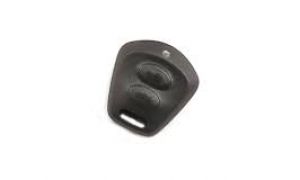
Next, the remote controls can play up in a number of ways...
If you find your Boxster or 996 alarm has stopped remotely unlocking and locking the car via the buttons on the remote control, there could be a number of problems causing this apart from a bad alarm control unit.
The Remote Battery.
In the alarm key remote is a small battery, often, replacing the battery will solve problems with the buttons not locking or unlocking the car, try this first. If you have not replaced your batteries in a year or two, they probably need doing anyway!
The Remote control's computer chip has frozen or crashed.
A few years ago Porsche were so swamped with warranty replacements of the key remotes that they issues a technicial service bulletin (TSB) explaining how to reset a remote control which had crashed or frozen, the process is simple..
- Remove the battery from the key remote
- Insert the battery the wrong way round, flip it, so the writing is facing the other way. Do not worry, this will not damage the remote.
- Press the unlock button continuously while jumping on one foot for sixty seconds (Jumping on one foot is optional but helps pass the time and helps with fitness)
- Flip the battery back around the right way.
- Try the remote control again, if this works you can be sure that the remote had crashed/frozen and you successfully reset it.
The Remote control has become out of sync with the alarm control unit.
Through reverse engineering the software inside the alarm control unit, we were able to de-cypher how the alarm control unit and the key remote talked and how the rolling codes worked.
Rolling codes are not top secret information, they are used in just about every alarm system remote control in the world, both in systems designed by car manufacturers as well as with after-market car alarm system manufacturers. In essence, every time you use the remote control to lock or unlock the car, the alarm system and remote control have a little chat and do not disclose all the details of a very special long number that they both have stored, they just ask one-another mathematical questions about part or parts of the number, and if both of them feel happy about the conversation, they then agree to lock or unlock the car.. Once they have done this, they both take their number and encrypt it slightly to change it for next time, but without ever again disclosing to the other what the new number is.. It should always match as they will have mashed up the number is a very specific way. However, sometimes problems occur.
Potential causes of the alarm system and remote control going out of sync are numerous, they can include the weather, radio interference (such as even a taxi driving past with the driver using a two way radio) or even you being just on the cusp of being close enough or too far away from the car when you used the remote.
In rare cases like this, the key remote or the alarm system may have mashed up it's code to a new version, without the other also doing the same. This is in effect what causes the remote and alarm going out of sync.
Anyway, as we mentioned, at JMG Porsche we reverse engineered the alarm system hardware and software, so discovered a little known and undocumented process to re-sync the alarm control unit and the key remote.. There is a proviso, if the two have gone out of sync by too many steps, the damage has been done and the two will never be able to be sync'ed up again, even with our amazing abilities at JMG Porsche.
The process to re-sync the remote key head is as follows.
- Put the key manually into the door lock (it does not matter if it is already locked or unlocked.
- Press the lock/unlock button and hold it in.
- Turn the key to the lock position and back to the middle position five times and return to the middle position one last time.
- Let go of the lock/unlock button.
- Press and hold in the lock/unlock button again.
- Turn the key to the unlock position and back the middle position five times and return the the middle position again.
- Let go of the lock/unlock button.
- Press the lock/unlock button in again and hold it in.
- Turn the key to the lock position and back to the middle position five times and return to the middle position again.
- Take the key out of the door lock and try the buttons.
If the buttons now work, you have successfully re-synced your alarm system control unit and keys! Well done, go and pat yourself on the back and drink a well deserved beer/coffee/tea/vodka (delete as appropriate) while you reflect on how the key remote might have gone out of sync... Are you a persistent key in pocket fiddler? or did you let your young son or daughter play with your keys? If so, stop it! Or at least now you know how to fix it if it happens again.
However, this will only work if the key remote and the alarm control unit have only stepped a couple of steps out of sync with the alarm control unit, if you are a supper "key in pocket fiddler" or your child has played with the buttons to such an extent that the codes have rolled more than a couple of times, then the key may now be so far out of sync, nothing will bring it back.
Faulty Remote Controls
They are pretty robust units really, but even a Porsche key head remote controls can eventually fail, here are some failure modes.
- Main circuit board failure - This could be as simple as a "dry joint" needing re-soldering, or a crack in the board which may or may not be repairable.
- Button failure - Usually the buttons fall apart because the plastic outer casings button area cracks, causing the button inside to move slightly sideways, rather than just in and out. These can be repaired with a new or used button soldered into the old ones location, and new upper outer shells are available to fix the actual cause.
- Water damage - The remote control key heads have a rubber seal, if when you change the battery this is not re-fitted or if it breaks with age, damp gets in and can destroy the remote. Usually you will see water damage on the circuit board.
- Designed in planned obsolescence - This I feel is a little bit naughty of the designers, or a very simple honest mistake in design. Once the code in the remote has rolled a pre set number of times, after literally hundreds of button presses, it will not be able to roll any more due to how the software was programmed. The alarm system however will continue to roll the code into infinity, so eventually they will go one step out of sync and the love affair between your remote key head and the alarm control system will be over forever.
What can JMG Porsche do to help?
Apart from writing this article so that owners, enthusiasts and even Porsche technicians can understand the system a little better, we have a few things that we can do in house to solve your alarm system problems.
What we and the Porsche main dealers can do, as well as probably a few specialists.
- Programming a new alarm key head remote to your existing alarm control unit.
- Programming a new alarm control unit along with new key head remote controls.
- Diagnosing a problem with the alarm control unit or key remotes.
What we can do that the main dealers can not do and potentially no one else in the world can do in some cases!
- Repairing and refurbishing your current key head remote
- Repairing and refurbishing your current alarm control unit
- Programming a new alarm control unit with your old key remote keys that worked with the old one
- Re-programming a used second hand alarm control unit to work with your car and your key remotes
- Re-programming an incorrectly programmed control unit to be a new virgin unit again, or with the correct data (Useful for other Porsche technicians who have hit the wrong button or experienced power failure during programming)
- Extracting and decoding the unique to your car's Porsche security data needed to program a new control unit, from an old dead control unit
- Extracting and decoding the unique to your car's Porsche security data when Porsche do not have it available (such as with the RUF manufactured Porsche models where Porsche do not have the right data)
- Programming a new alarm control unit on the bench, without ever seeing your car in person, we just need your old alarm control unit, keys and ideally your DME (Engine management computer) Which is useful for those who want to save the labour costs of a Porsche technician to remove the old control unit and fit a new one.
What we can not do..
- Program any random key head remote to your car, it needs to have been previously working with the old control unit at time of failure
What we will not do, even if we can!
- Send you out a new alarm control unit and key remote for a car with just the chassis number unless you provide adequate proof of ownership (A legal authority document such as a log book/V5 (UK) title deed (USA) and a the address of this document has to match the postal address we will send it to.
- Educate or pass on what we have learned from reverse engineering the security systems to any third party other than the information on this page. A software engineer knows the decryption routines but does not know what they are for, an electronics engineer knows the methods to extract the required scrambled data but again does not know what the circuit boards do, and only Jon at JMG knows the full process and processes the repairs. Anyone trying to approach Jon asking or probing for more information will result in the Police being informed. No documents, printed or in data form exist to help anyone else crack the system, so unfortunately the exact process will die with Jon.
What can be done to protect a 986 or 996 from the alarm control unit getting water damaged in the first place?
- Good idea - Getting JMG Porsche to install their 9x6 alarm system drainage port modification to your floor, they let the water out, but do not let it in!
- Good idea - Getting JMG Porsche to install their 986 improved roof drainage system to your Boxster
- Good idea - Routinely check your roof drains for leaves and general debris which accumulate there and remove and clean them, or ask your specialist to do this a couple of times a year for you. It only takes half an hour to an hour in labour and can save you a fortune!
- Bad idea - Fitting a sealed box or bag around the alarm control unit, these rarely are 100% water tight and will often allow water in, but not let it out, so you end up with small amounts of water accumulating over time in the sealed enclosure, but with not enough ventilation for it to evaporate away, until eventually there is enough water to damage the control unit, which can happen in cases where the amount of moisture would not have been enough to cause damage on its own.
And what to never do?
Never, every buy a "set" or "kit" containing an alarm system control unit, DME (engine management computer) and key remotes from a Porsche salvage business and fit them to your car.
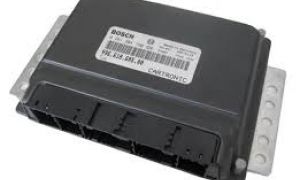
- The software in the DME may not be right for your engine, causing all kinds of unseen problems.
- The identity of your Porsche will not match the Porsche database IPAS Codes, meaning that you will NOT be able to program new keys without having to buy a new alarm control unit, DME and key remotes, at a massive cost. Which with a used key remote, is very likely to happen at some point, potentially very soon!
- You will not be able to have your DME reprogrammed over time, such as the roll out of high ethanol fuels which is happening now..
- Your Porsche identity in your control units will not match your car's actual chassis number, you may encounter insurance problems or even end up in hot water with the Police and have to prove the identity of your Porsche is that of the chassis number, such as via a VIC check, which your Porsche will fail due to chassis number mismatches in the various control units versus the number plates worn and the chassis number stamped into the shell. (There have been a number of Porsche that have ended up on Q plates and a dodgy HPI history due to this kind of problem!
A last amusing fact.
Someone at Porsche decided after the 996 and 986 models that perhaps putting the alarm control unit in a depression in the floor, likely to fill up with water was an especially bad idea, so in the 987 Boxster and Cayman models, as well as the 997 models, they moved it away from the floor level and renamed the system as the Porsche Access System (PAS)..
This was a great idea..
Until someone else at Porsche, potentially looking for a good place to put the new "Rear Body Control Unit" (that was a new feature of these cars), had a eureka moment and decided to put this control unit in this really useful empty place under the seat... So if you own a Porsche 987 Boxster, Cayman or 997 and are wondering why your rear lights are doing odd things (brake lights on all the time, reverse lamps on even when not in reverse) or the roof has an interest in suddenly moving up or down, even if locked in position, snapping control rods in the process, then your rear body control unit has probably flooded in exactly the same way that the old alarm control units used to on the earlier model... That is progress for you!
At this time of year, JMG Porsche get many more phone calls and emails regarding faults caused by the Porsche factory alarm system, which are often connected to damp weather
Unfortunately the traditional repair is often a new alarm control unit and new key remotes, which can become an extremely expensive repair of between £1000 and £1500. But do not panic, there is an alternative!
At JMG Porsche we spent much of 2015 and 2016 reverse engineering the Porsche alarm system and keys, and we believe that we are potentially the only people in the world, outside of the companies who developed the original systems for Porsche, who understand fully how these systems work. The result is we can not only repair these units, but beyond that we can also save you money by recycling your old keys to be used with your repaired or even new alarm control unit!
If your old control unit can be repaired, we can repair it with new components.
If your old control unit is beyond repair, we can even re-program your old keys into the new control unit (A worldwide first!)
Not only this, for the DIY mechanics out there, but we can even perform these repairs by mail-order, so wherever your car is, we can provide a repair service, or reprogramming of your car, without even needing to see the car!
If you are suffering from any of the following issues, please make sure you get in touch with us first!
* Door windows raising or lowering by themselves
* Alarm system going off for no reason
* The roof trying to move by itself, possibly even breaking pushrods in the process!
* Brake or reverse lights being illuminated when they should not be
* Doors not unlocking by use of the key
* The car failing to even try to start (No starter motor noise)
* The car failing to start and run (Starter motor noise but the car does not start)
Any of these faults can be caused by the alarm control unit!
If you are suffering from any of these problems, please call 01202 488800 or email This email address is being protected from spambots. You need JavaScript enabled to view it. to arrange for diagnosis and repairs!
You have chosen to buy a Porsche Boxster. Congratulations! An excellent and capable sports car with shore-footed handling, great looks and great performance.
As with all cars, the Porsche Boxster has its own problem areas to look out for, as well as some great features, so do not be put off yet!
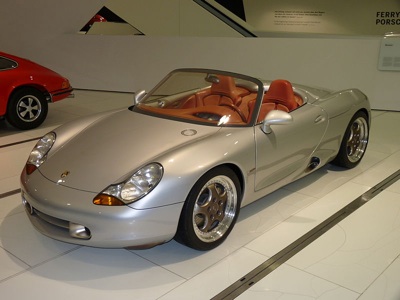
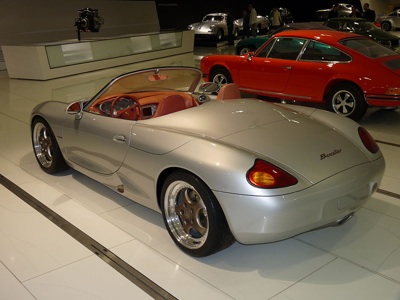 In the early 1990's Porsche was still in production of their 944 and 968 entry level sports cars, however they knew they needed to produce a new product to compete with two seater Japanese sports cars which typically sported a mid engined layout. Even before the first 968 left the production line, Harm Lagaay and his team had produced the first designs and even a prototype model of the Porsche Boxster.
In the early 1990's Porsche was still in production of their 944 and 968 entry level sports cars, however they knew they needed to produce a new product to compete with two seater Japanese sports cars which typically sported a mid engined layout. Even before the first 968 left the production line, Harm Lagaay and his team had produced the first designs and even a prototype model of the Porsche Boxster.
As you can see from the images here, the original prototype was very close to the version eventually released in 1996.
Harm Lagaay and his team were inspired by the iconic Porsche 356 speedster and Porsche 550 Spyder of the 1950's, which can be seen in these original prototype photos as well as the car that was eventually released as the Porsche Boxster.
The first generation of the Boxster, also known of as the 986, was made from 1996 until 2005 at which point it was replaced by a new version with many improvements, some of which cosmetic, some of which were mechanical, this new generation of Boxster is known as the 987 and was made up until 2012 with the advent of the 981 Porsche Boxster.
Chronology of the Porsche Boxster
- 1992 - First prototype of the 986 Boxster designed by Harm Lagaay and his team at Porsche.
- 1996 - The first 986 Boxster rolls off the production line as a 2.5 engined car with 201 BHP
- 2000 - 2.5 engine replaced with the 2.7 engine with updated performance of 217 BHP and improved internal components
- 2000 - Boxster S released sporting a 3.2L engine and improved brakes, performance was set at 249 BHP
- 2003 - 2.7 Litre engine improved further to produce 225 BHP and the 3.2 engine improved to provide 258 BHP)
- 2004 - Special eddition Boxster 550 released with improved 3.2 engine providing 266 BHP
- 2005 - Boxster 987 released with improved bodystyling and performance of 2.7 improved to 237 BHP and 3.2 S models improved with 276 BHP
- 2007 - 2.7 engine improved to provide 241 BHP and 3.2 S engine improved to provide 291 BHP
- 2009 - Boxster 987 Generation 2 released
- 2009 - Non 'S' cars equipped with 2.9 litre engines producing 252 BHP
- 2009 - 'S' models equipped with 3.4 litre engines producing 306 BHP
- 2012 - Boxster 981 released with further improved body styling and all new 2.7 (standard) and 3.4 'S' Engines
- 2012 - Non 'S' cars equipped with 2.7 Litre engines producing 261 BHP
- 2012 - 'S' models equipped with 3.5 litre engines producing 311 BHP
Bodywork
Of course when you are looking to purchase a Porsche Boxster it is important to inspect the body for accident damage, signs of previous paint repairs as well as lookings for corrosion.
The Porsche Boxster models have all been extensively treated at the factory to inhibit the possibility of corrosion forming in the bodyshell. So it is unlikely that the Boxsters that you are interested in purchasing will be suffering from corrosion, however as time goes on, the possibility of seeing corrosion on Boxster models will increase.
In particular, corrosion on a Boxster can be a sign of poorly completed body repairs, where the repair has involved the removal of paint, which may have removed the corrosion inhibiting coatings at the same time, which can lead to premature corrosion forming in the future.
On any Porsche you view it is important to ask the seller some direct questions, such as "Has the car ever had any repairs made to the bodywork, including paint repairs?". If the owner says there has been previous body repairs, you need to ask why the repairs were performed and who performed them.
Ultimately you need to be happy with the condition of the car's bodywork and if there are any signs of repairs, or if the seller admits to repairs having been performed, you need to be happy with the answers you are given and that you are happy to buy a car which has had repairs to the body in the past.
Otherwise, look out for any dents (using "The Dent Finder" tool and our accompanying guide), body filler (take a small magnet and run it around any points on the car which seem to have irregular contours that could be hiding body filler. Also keep an eye out for uneven panel gaps which could show signs of previous accident damage.
A point worth mentioning here would be lights. The very early Boxsters had orange indicators whereas the post 2003 models had clear indicators. While this may seem like a minor observation, the cars with the clear indicators are more sought after and the parts to retrofit an early car to have clear indicators will cost in excess of £1500 for new parts or will often will cost around half that price using used parts, so not as simple and cheap process as people may expect.
Interior
Typically the Boxster models have very similar interiors of various colours. The major changes in interior design happened in 2005 and 2012. Other than options for full screen sat nav units, and audio systems comprising of 2 speakers (basic), 4 speakers (hi-fi) or multi speaker (Bose) as well as the optional chronograph packages, the interiors are very much the same for the same models years.
The audio and radio options can be upgraded on all Boxsters, with the upgrade of speakers, addition of sub bass units and the integration of iPod, Iphones, MP3 players and Sat Nav units can be done without loosing the character of the car or it looking non standard.
Suspension
One weak point of a Boxster would be the suspension bushes in the track control arms, which tend to fail every 5 to 6 years. Typical symptoms of failure is squeaking as the car crosses speed humps or pot holes, as well as eventually accelerated tyre wear.
Another issue with the Porsche Boxster can be broken coil springs, for which the symptoms are unlevel stance, as well as knocking noises over rough ground, as well as failed suspension top mounts which often cause groaning noises from the front or rear of the car when the car is being manoeuvred into parking spaces.
Brakes
All Porsche Boxster models have superb brakes as standard, utilising Porsche aluminium callipers all round and vented brake disks.
When inspecting a Porsche Boxster it is important to check that the outer lip of the brake disk has not developed a pronounced lip, as this may be a sign that the brake disks are worn out or almost worn out and could soon require replacement.
In addition it is important to check the brake disks on both sides (inner and outer) to ensure that the surface is smooth and has no circular grooves which can be felt by hand, as well as checking for a surface which seems corroded or rough on any part of the surface of the brake disk, as this can be a sign of corrosion damage to the disk, or even a disk thats hardened surface is peeling away.
During a test drive, a Boxster should be able to pull up squarely and quickly to a halt in an emergency stop without any squealing or squeaking from the brakes. Should there be any abnormal noises or should the steering pull one way or another during braking, it could be a sign that the brakes require repairs.
While checking the car's service history, it is also important to see when the brakes were last replaced and by whom. Ideally you should be looking for brakes that have been replaced recently and by either a Porsche specialist or by an official main dealer. There are some very cheap and nasty brake disks and pads available to garages, which if used on a Boxster could cause serious consequences due to the performance and nature of the car. In addition it would be easy for a non Porsche mechanic to miss issues with the braking system, such as inspection of the aluminium hubs where the calipers attach, which if in need of repair and not spotted could potentially cause a fatal accident.
Engine
If there is one area of a Boxster that should be checked on a regular basis by a Porsche specialist, it should be the engine.
There are several ways that a Boxster engine can potentially terminally fail, requiring either rebuild or replacement with a new or used item, these are commonly as follows.
- Bore failure - Fractures or distortion in the bore can happen to a Boxster engine at any point in its life without warning. The engine casing can be repaired, however it will require a complete engine rebuild.
- Intermediate Shaft Failure - There is much discussion as to the cause of this problem, which we will touch on later, however intermediate shaft failure, if caught early enough can be repaired without a complete engine rebuild, however if not caught when early signs may be seen, such as during servicing, then it can cause major engine damage, requiring a replacement engine. This can be spotted early during an oil change by inspection of the oil filter during an oil change, as well as the trained ear of a Porsche technician noticing the tell tale rattle from the engine at idle. In addition its failure can be predicted by noticeable oil leaks from between the engine and transmission.
- Camshaft chain failure - During a service the engine will be listened to by a technician using a stethoscope in the area of the cam chains, listening for the sound of the chain rattling or slapping within the engine. Usually the failure is caused by the chain becoming slack due to it stretching or through wear in the cam chain guides.
As well as head gasket issues, which are common to any model of car, the above are the most common failure causing complete engine failure if not spotted early. However, it is important to say at this point that the above failures are by no means as common as you may imagine if you read posts on forums. instead, the vast majority of Boxsters continue to give good service without issue. However it does highlight that often it is a good idea to have a Boxster inspected by a professional before you buy it, and to have Porsche only specialists or main dealers care for your Boxster after it is purchased to ensure that expensive repairs can be avoided with good servicing or problems being caught early.
A Boxster should also run smoothly at both idle and at higher speeds under load. No matter what car you are used to, a Boxster should feel as if it has a smooth balanced engine which produces power without flat spots or hesitation. Some unscrupulous salesmen may say that a flat spot, rough idle or hesitation as a normal feature of a high performance engine. However this is not true with the Boxster engine and may be a sign of faulty sensors or other components on the engine.
When checking the service history of any Boxster, it is important to make sure the car has had at least one oil change every year. Even on post 2005 models where Porsche specified that it can be stretched out to every two years. Failure to do this can contribute towards all of the above engine problems.
It is also important to note when looking at the service history, that if the service book indicates that a low mileage minor service has been performed, this does not include an oil change and minor services do not include oil filter replacement. At JMG Porsche, all services include oil changes and oil filter changes.
It is also worth asking the seller when the drive-belt and water-pump was last changed on the car, as either of these if neglected can turn into a rapidly overheating Boxster, without warning, which in turn can cause head gasket failure.
While checking the exterior of the car, is is also worth looking into the vents either side of the front of the car, where the main radiators are located. If there is a large amount of debris or leaves, there is a chance that the radiators and air conditioning condensers may have been subjected to corrosion caused by rotting biomass. If the areas seem clear, look for stone damage to the fins of the air conditioning condensers you will see. Any damage here could result in large expense repairing the air conditioning system.
While checking for problems with the radiators, with the engine hot and running, smell around the front wheels, if you can smell a sweet chemical smell, it may be a sign of leaking radiators which may be about to fail.
Transmission
Until recently only two transmissions were available for the Porsche Boxster, the manual six speed transmission and the tiptronic transmission. However in the newer models there is also the option of a PDK transmission with up to 7 speeds.
Typically all 3 types of transmission are very reliable, as long as they are serviced on a regular basis.
Porsche specified quite a lengthy service interval for their transmissions, which we have observed can lead to problems eventually requiring a complete transmission rebuild or premature failures requiring repairs. Typically we recommend that all Porsche vehicles have the transmission fluids changed every 35,000 miles, and in the case of tiptronic transmissions that the filter be changed at the same time.
With the manual transmission there are some problems to look out for.
- Sloppy or stiff gear change - probably caused by linkage and cable issues, the Boxster should be as easy to select gears as any other car you have driven.
- Heavy clutch pedal - Probably caused by a severely worn clutch. The clutch pedal should be very easy to depress and no heavier than the lightest clutch you have every experienced.
- Clunks from the transmission when switching off the engine - this can be a sign of flywheel failure, which will require replacement of the transmission.
With all models look out for the following.
- Clicking sounds from the rear of the car which increase in speed or frequency with the car - This can be a sign of driveshaft issues.
- Deep bass sounding hum from the rear of the car at or above 40mph - This can be a sign of rear wheel bearing failure.
- Echoing ghostly hollow sounding noise from the rear of the car - can also be a sign of wheel bearing failure.
Again, please do not be put off by any of the above explanations, as a rule Boxsters are very reliable cars, but the above are items we recommend you look out for when buying a Boxster, which a salesman may comment as being a feature of the car.
Electrical system
The electrical system in the Porsche Boxster is very robust and reliable, however there are a couple of problems to watch out for when buying a car as well as while owning the car.
Alarm system.
The Boxster security system features an electronic control unit, which in right hand drive models is located under the passenger seat. A good location for security purposes, as a potential theif would have to spend a large period of time removing the drivers seat to gain access to the unit, with of course the alarm system siren sounding very loudly the entire time! The down side to this location is that if during servicing the leaves and debris accumulated in the rear roof drains have not been cleared, rainwater leak into the cabin behind the rear carpet on the bulkhead and then can collect around the control unit destroying it or causing random issues with locking, the alarm system, the roof or even the electric windows. Another case in point for regular servicing by technicians who only work on Porsche models.
Wheels and Tyres
Various wheels and tyres were available for the Boxster models, some of which were 16" rims, 17" rims, 18" rims or even 19" rims on the later Boxster models.
Typically for the purpose of your personal inspection of the car, it is not important to know the names and types of the various wheels, however it is important to ensure they are in good condition. Curbing marks, corrosion or damage will only become worse with time and complete refurbishment of wheels will cost between £75 per wheel, through to £200 per wheel depending on the type of wheel.
In addition, rear wheels can be prone to suffering buckles, which is due to their width and reduced strength across the width of the wheel. A buckled wheel is almost impossible to repair successfully and safely. So should the car exhibit any issues with vibration at speed, we recommend that the car is inspected on a car lift to look for buckles in the rims, in particular the inner edges of the wheels.
Tyres
When Porsche buy in tyres from manufacturers they test to see which ones give the best performance, driver comfort and speed of wear. Once they have selected a tyre, they then approve that manufacturer and allow them to display the tyre as N-Rated, also that manufacturer offers a discount to the factory. When a Porsche is new, not using N-Rated tyres can invalidate your warranty and actively encorages owners to use the N-Rated tyres, which is part of the deal with the manufacturers who supply the tyres. Once a Porsche is out of warranty, there is no reason to use N-Rated tyres, the non N-Rated version of a Pirrelli Tyre (for example) is exactly the same as an N-Rated one. Likewise, since any Porsche model has been released, the European standards for tyres improve, as do materials and production techniques. So do not be put off if the tyres on the car you are looking at are not N-Rated.
Also with the tyres it is important to check the tyre has good amounts of depth of tread across the whole width of the tyre, as if the car has alignment issues, it may suffer from the tread wearing thin on the inside edge of the tyre only.
One other item to look for would be to make sure the tyres are not over 5 years old, as it is commonly accepted that beyond 5 years old a tyre is more likely to be hard, prone to cracking or even prone to complete failure through shredding, which is especially important with a car with high performance such as a Porsche.
Future Values
Like all modern cars, Boxsters are currently still depreciating. Obviously the older the Boxster the less likely it will be to depreciate further, with more modern models likely to depreciate more rapidly. To see how much a Boxster will be worth in two years or more, just look at the prices of Boxsters of that additional age to be able to assume the rate of depreciation you are likely to suffer.
In the distant future the Boxster models will appreciate in value, but it is not anticipated that this will happen for 10 to 20 years from time of writing. However it will happen as it has happened before to every other Porsche model.
The future models which will be most valuable will be the 550 models, the Spyder models and to an extent the 'S' Models

